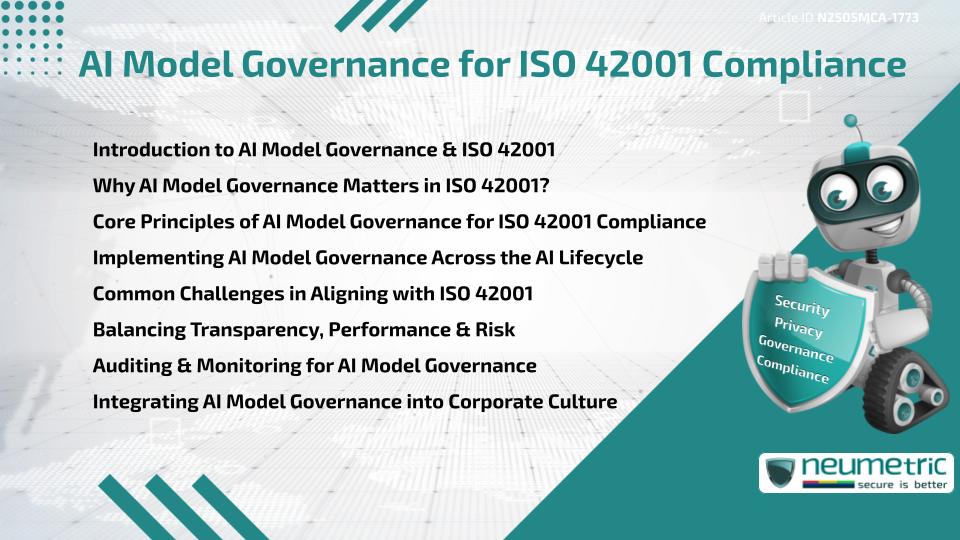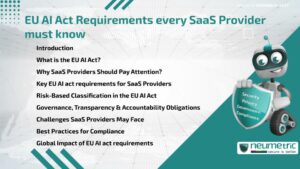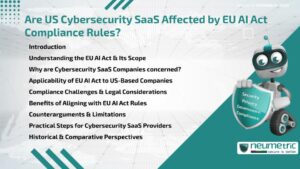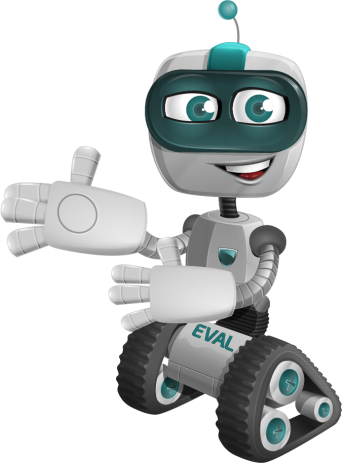Table of Contents
ToggleIntroduction to AI Model Governance & ISO 42001
As Artificial Intelligence becomes central to decision-making, managing its Risks & ensuring responsible use have become essential. The ISO 42001 Standard addresses these concerns by providing a structured approach to govern the development & deployment of AI Systems. At the heart of this Framework lies AI Model Governance for ISO 42001 Compliance, which focuses on managing the lifecycle of AI Models to ensure they are safe, ethical & aligned with organisational objectives.
This article explores what AI Model Governance means in the context of ISO 42001, how it works in practice & why it’s vital for enterprises seeking to build trust in their AI Systems.
Why AI Model Governance Matters in ISO 42001?
AI Model Governance for ISO 42001 Compliance is not merely a regulatory checkbox. It plays a central role in demonstrating that AI Models behave as expected, are explainable & are subject to human oversight.
Without structured Governance, AI Systems Risk becoming unpredictable or biased. ISO 42001 aims to prevent this by mandating documented controls, Continuous Monitoring & accountability mechanisms that span across development, deployment & ongoing use.
Governing an AI Model under ISO 42001 ensures:
- Transparency in decision logic
- Mitigation of unintended outcomes
- Alignment with Stakeholder values
- Readiness for Internal & External Audits
Core Principles of AI Model Governance for ISO 42001 Compliance
To support AI Model Governance for ISO 42001 Compliance, organisations must follow key principles that apply throughout the AI lifecycle. These include:
Accountability & Role Assignment
Clearly defined roles for AI designers, data scientists & business owners help ensure each Stakeholder is accountable for model quality & ethical use.
Risk-Based Controls
Governance should be driven by Risk. The more significant the AI impact, the more rigorous the validation & documentation required.
Traceability & Documentation
Model lineage, version history & training data sources must be documented to support traceability, a core ISO 42001 expectation.
Human Oversight
AI Systems must not operate in a black box. Human review, override mechanisms & escalation processes help mitigate harm.
Implementing AI Model Governance Across the AI Lifecycle
To implement AI Model Governance for ISO 42001 Compliance, organisations must embed controls at each stage of the AI Model lifecycle:
- Design Stage: Set clear goals, define metrics & determine acceptable Risk levels.
- Development Stage: Use reproducible processes, ensure explainability & validate training data.
- Deployment Stage: Include rollback plans, performance monitoring & security hardening.
- Post-Deployment Stage: Monitor drift, log User interactions & update models responsibly.
The OECD AI Principles also support these stages by encouraging fairness, transparency & robustness in AI Development.
Common Challenges in Aligning with ISO 42001
Organisations may encounter several obstacles when pursuing AI Model Governance for ISO 42001 Compliance. These include:
- Lack of clarity on roles: Especially in cross-functional teams.
- Inconsistent documentation: Especially when teams lack shared templates or tools.
- Toolchain fragmentation: Using multiple platforms for data, training & deployment can reduce oversight.
- Low model explainability: Particularly for deep learning models, which can obscure decision paths.
One practical approach is to adopt a Governance checklist aligned with ISO 42001 requirements, ensuring consistency across teams & processes.
Balancing Transparency, Performance & Risk
One of the key tensions in AI Model Governance for ISO 42001 Compliance lies in balancing transparency & performance. For example, interpretable models may be preferable for Compliance but could underperform compared to opaque models like neural networks.
ISO 42001 encourages context-based decision-making—organisations should choose models that are both fit for purpose & manageable under Governance requirements.
Striking this balance involves:
- Defining Risk tolerance thresholds
- Involving Stakeholders early
- Prioritising models with sufficient explainability when used in high-impact settings
Auditing & Monitoring for AI Model Governance
ISO 42001 emphasises periodic review & Continuous Improvement. As such, AI Model Governance for ISO 42001 Compliance must include:
- Scheduled Audits: Checking if the model behaves as intended under various conditions
- Monitoring for Drift: Detecting performance degradation over time
- Audit Trails: Keeping logs of predictions, user feedback & updates
These elements help demonstrate that the model remains trustworthy & that Governance is not a one-time exercise but a continuous responsibility.
Integrating AI Model Governance into Corporate Culture
To truly benefit from AI Model Governance for ISO 42001 Compliance, organisations must go beyond checklists. Governance needs to be part of the culture. This involves:
- Training teams on ethical AI
- Incentivising responsible innovation
- Encouraging open discussions about Risks & failures
- Aligning Governance goals with business outcomes
By embedding Governance into daily operations, organisations build long-term trust & resilience.
Takeaways
- AI Model Governance is central to ISO 42001’s approach to responsible AI.
- Governance must span the full AI lifecycle from design to decommissioning.
- Continuous auditing & monitoring are required to meet ISO 42001 expectations.
- Governance must be supported by a culture of accountability & awareness.
FAQ
What is AI Model Governance in the context of ISO 42001?
AI Model Governance refers to the structured oversight of how AI Models are developed, deployed & monitored to meet ISO 42001 standards for responsible AI.
How does AI Model Governance reduce Risk?
By embedding controls, reviews & documentation across the AI lifecycle, model Governance helps prevent unintended consequences & supports safe AI usage.
Is model transparency mandatory for ISO 42001 Compliance?
While ISO 42001 does not enforce specific model types, it requires sufficient transparency to ensure explainability, auditability & human oversight.
What are the most useful tools for AI Model Governance?
Model cards, AI FactSheets, automated Audit systems & version control tools all support effective Governance in line with ISO 42001.
Can deep learning models be governed under ISO 42001?
Yes, but they may require additional explainability techniques & human oversight to meet the standard’s Transparency & Accountability expectations.
How often should AI Models be audited for ISO 42001?
Regular Audits should be scheduled based on the model’s Risk level, with mechanisms in place for continuous performance monitoring & documentation.
Who is responsible for ensuring AI Model Governance?
Responsibility should be distributed across roles such as data scientists, engineers, legal teams & business owners, each accountable for different Governance areas.
Does ISO 42001 apply only to large enterprises?
No, ISO 42001 is designed for any organisation using AI, large or small & can be adapted to the scale & complexity of different AI applications.
Need help?
Neumetric provides organisations the necessary help to achieve their Cybersecurity, Compliance, Governance, Privacy, Certifications & Pentesting goals.
Organisations & Businesses, specifically those which provide SaaS & AI Solutions, usually need a Cybersecurity Partner for meeting & maintaining the ongoing Security & Privacy needs & requirements of their Clients & Customers.
SOC 2, ISO 27001, ISO 42001, NIST, HIPAA, HECVAT, EU GDPR are some of the Frameworks that are served by Fusion – a centralised, automated, AI-enabled SaaS Solution created & managed by Neumetric.
Reach out to us!





